When it comes to creating a space for studying, comfort and productivity go hand in hand. Whether you’re a student preparing for exams or a professional working on projects, the design of your study room design plays a crucial role in ensuring you remain comfortable and focused during long study sessions. In this article, we’ll explore how to make your study room comfortable for extended hours of study by considering various aspects of Study Room Design, such as furniture, lighting, ergonomics, and overall ambiance. If you’re looking for expert guidance on creating a study room that promotes comfort and focus, the best interior designers in Bangalore can offer personalized advice that aligns with your specific needs. Let’s dive into the essential factors that contribute to a study room design that makes long study sessions more manageable and efficient.
1. Ergonomic Furniture: The Foundation of Comfort
The most crucial aspect of study room design is the furniture. The right furniture ensures that you maintain good posture, preventing physical strain during long study hours. Here are some ergonomic furniture essentials for your study room:
- Comfortable Chair: A well-designed chair is essential for supporting your posture. Choose a chair that offers lumbar support, adjustable height, and armrests to avoid back pain and strain on the neck and shoulders.
- Study Desk: Select a spacious desk with enough room for your books, laptop, and other study materials. Ensure the desk height is suitable for comfortable working, with your elbows at a 90-degree angle while sitting.
- Standing Desk Option: Consider using a standing desk or an adjustable sit-stand desk to alternate between sitting and standing. This can prevent fatigue and improve circulation during long sessions.
- Footrest: For additional comfort, use a footrest if your feet don’t comfortably touch the ground. This can help reduce pressure on your legs and improve posture.
2. Proper Lighting: The Key to Focus
Lighting plays a significant role in your study room design. Insufficient or harsh lighting can cause eye strain and headaches, which can interfere with your concentration and productivity. The goal is to create lighting that is bright enough to prevent eye strain but soft enough to avoid discomfort. Here’s how you can achieve the perfect lighting setup:
- Natural Light: Whenever possible, take advantage of natural light. Position your desk near a window to maximize exposure to sunlight. Natural light is soothing and helps maintain focus.
- Task Lighting: Invest in task lighting, such as adjustable desk lamps, to illuminate your study materials without casting shadows. A good desk lamp with adjustable brightness can make a significant difference in reducing eye strain.
- Ambient Lighting: Incorporate soft ambient lighting around the room to avoid harsh contrasts between your workspace and the rest of the room. This can create a more balanced and comfortable environment for long study sessions.
- Accent Lighting: Consider adding accent lighting for aesthetic purposes. This can include soft floor lamps or wall sconces, which can also improve the overall ambiance of the room.
3. Optimizing Temperature and Ventilation
A comfortable temperature and good ventilation are essential for long study sessions. Being too hot or too cold can make it difficult to concentrate, leading to fatigue and distractions. Here are some tips for optimizing the temperature and ventilation in your study room:
- Air Conditioning or Fans: Use an air conditioner or a ceiling fan to maintain a comfortable temperature in your study room. A fan can help circulate the air and prevent the room from feeling stuffy, especially during summer months.
- Heating: If you’re studying in a cooler climate or during the winter, ensure that your room is adequately heated. A small heater or even an electric blanket can make a difference in staying comfortable during cold study sessions.
- Windows and Ventilation: Ensure proper ventilation by opening windows periodically to let fresh air in. Proper airflow can help prevent the room from feeling stuffy and keep you energized.
4. Clutter-Free Environment: Boosting Focus and Productivity
A cluttered room can create unnecessary distractions, making it hard to focus during study sessions. A clean and organized study room is essential for maintaining concentration and ensuring comfort. Here’s how you can achieve a clutter-free environment:
- Declutter Regularly: Ensure that your study desk is tidy and free of unnecessary items. Keep only the essentials on your desk, such as your study materials and a laptop. Store books, files, and stationery in cabinets or shelves to keep your workspace organized.
- Use Storage Solutions: Invest in storage solutions like shelves, file cabinets, and drawer organizers to keep everything in place. Consider vertical storage to maximize space if you’re working with limited room.
- Cable Management: Use cable organizers to keep wires and cables under control. This helps prevent a tangled mess and creates a cleaner and more organized workspace.
5. Personalized Décor: Creating a Motivating and Comfortable Atmosphere
While a minimalist design can promote focus, adding some personal touches to your study room can make it a more inviting and motivating space. Personalizing your study room with soothing décor elements can enhance both comfort and productivity. Consider the following:
- Artwork and Wall Décor: Hang motivational quotes, artwork, or calming visuals on the walls. This can inspire creativity and add a sense of warmth to your space.
- Plants: Indoor plants can improve air quality and provide a calming presence. Consider placing a few low-maintenance plants, such as succulents or snake plants, on your desk or windowsill.
- Color Palette: Choose calming and neutral colors for the walls, such as soft blues, greens, or light neutrals. These colors are known to enhance concentration and reduce stress. You can incorporate accent colors to add personality and vibrancy to the space.
- Comfortable Accessories: Add comfort with cozy accessories such as a soft rug, throw pillows, or a comfortable chair cushion. These elements will make your study room feel more welcoming and relaxing.
6. Technology and Smart Features for Convenience
In today’s digital age, integrating technology into your study room design can make your study sessions more efficient and comfortable. Consider the following smart features for your study room:
- Smart Lighting: Use smart bulbs that allow you to adjust the brightness and color temperature depending on the time of day or your mood. This can enhance the lighting experience and contribute to your comfort.
- Sound Systems or Noise-Canceling Headphones: If you’re studying in a noisy environment, a good pair of noise-canceling headphones can help you focus. Alternatively, you can use a sound system to play relaxing background music that improves concentration.
- Charging Stations: Designate a space for charging your devices, such as your laptop, phone, and tablet. A dedicated charging station prevents clutter and ensures that your devices are always ready for use.
Conclusion
Designing a study room that is both comfortable and conducive to long study sessions is essential for maintaining focus and productivity. By paying attention to ergonomic furniture, lighting, temperature, organization, and personalized décor, you can create an environment that supports your academic and professional goals. If you’re unsure how to approach your study room design, seeking advice from the best interior designers in Bangalore can provide you with expert guidance tailored to your space and needs. With the right study room design, you can transform your workspace into a comfortable, efficient, and motivating environment that enhances your productivity and well-being during long study sessions.



